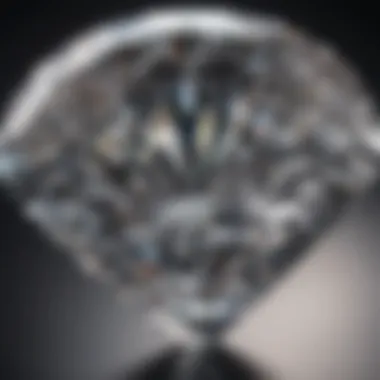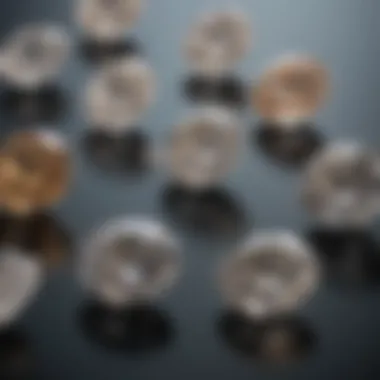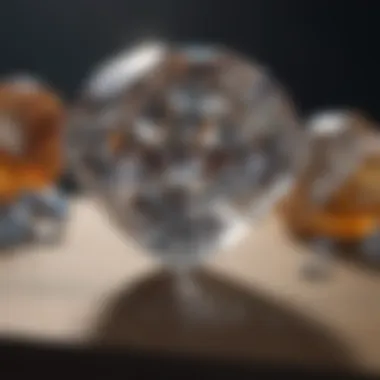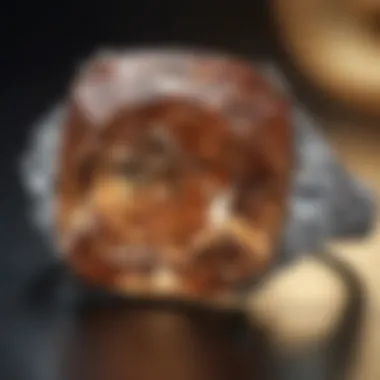Understanding the Value of Diamond Cuts


Intro
In the world of gemstones, diamonds hold a unique position. Many see them as symbols of love, commitment, and status. Yet, beyond their emotional connections, diamonds possess a complex value structure influenced heavily by their cuts. The way a diamond is cut can significantly impact its brilliance, appearance, and, more importantly, its overall value. This article investigates various diamond cuts and their implications on market price. With a focus on understanding what makes some cuts more expensive than others, readers will gain insights essential for informed purchases.
Gemstone Overview
Definition of Gemstones
Gemstones are minerals or rocks that are esteemed for their beauty, rarity, and durability. They are typically cut and polished to enhance their aesthetic appeal. Diamonds, along with other gemstones, have formulations leading them towards characteristics such as hardness, color, and clarity, determining both their use and value on the market.
Classification of Gemstones
Gemstones can be classified into various categories. Precious stones like diamonds, rubies, sapphires, and emeralds often hold significant monetary weight. In contrast, semi-precious stones like amethyst, turquoise, and garnet also have market presence but are generally lower in price. Classifications are further divided based on several factors, including:
- Composition: the chemical makeup of the stone.
- Origin: where the gemstone is sourced from, various localities can impact price.
- Color: various diamond colors affect their demand and value.
"The cut of a diamond remains one of the most important aspects determining its value."
The Importance of Diamond Cuts
When focusing specifically on diamonds, the cut refers to how a diamond is shaped and faceted. It can profoundly enhance or diminish its light performance.
Some common cuts include:
- Round Brilliant
- Princess
- Emerald
- Cushion
- Asscher
Each has its unique shapes and facets, influencing brilliance and scintillation. The quality of the cut, the skill of craftsmanship, and the final polish dictate how light interacts with the diamond, which directly affects its value. The round brilliant cut is often the most expensive due to its popularity and ability to maximize brilliance.
Understanding these variations provides insight for buyers and collectors alike. Potential buyers should consider their preferences and the inherent value each cut brings to the table. This overview serves as a foundation, setting the stage for a deeper understanding of how diamond cuts influence their market worth.
Prelims to Diamond Cuts
Diamond cuts serve as a fundamental aspect of gemology, influencing both the aesthetic appeal and the monetary value of these precious stones. Understanding the various diamond cuts is crucial for gemstone enthusiasts, collectors, jewelry designers, and geology aficionados. Each cut expresses the craftsmanship of the diamond's creator while also impacting how the diamond interacts with light, affecting its brilliance and scintillation.
By diving into the specifics of diamond cuts, one can gain insight into what makes a diamond truly valuable. In the pursuit of the perfect stone, discerning buyers must grasp how cuts define the overall beauty and desirability of a diamond. The cut not only dictates visual charm but also plays a pivotal role in the market demand, which ultimately influences pricing.
Defining Diamond Cuts
Diamond cuts refer to the specific shape and facets applied to a diamond during the cutting process. Each cut results in a unique arrangement of facets, which are the flat surfaces that reflect light. Some popular cuts include Round Brilliant, Princess, Emerald, and Asscher cut.
The round brilliant cut is often seen as the benchmark, renowned for its ability to maximize light return. Alternatively, the princess cut appeals to those who prefer a modern aesthetic with its sharp lines and contemporary feel. Each cut possesses distinct characteristics that can either enhance or detract from a diamond's overall allure.
Importance of Cut in Diamond Quality
The cut of a diamond is arguably the most significant factor affecting its quality. It defines how well a diamond can reflect light, thereby determining its brilliance and sparkle. A well-cut diamond will exhibit a more intense interaction with light, creating an enchanting effect.
Poorly cut diamonds may appear dull and lackluster, regardless of their other attributes such as color and clarity. Thus, the investment in a high-quality cut can substantially amplify the visual and emotional value of a diamond.
In summary, the diamond cut serves as a critical indicator of both beauty and price. Understanding its nuances can empower buyers in making informed choices when selecting precious stones.
Key Factors Influencing Diamond Value
Diamond value is not determined solely by one factor. Several components come into play, and understanding them is essential for both buyers and sellers. This section will emphasize the critical elements that influence the pricing and desirability of diamonds. Recognizing these factors can help navigate the intricate world of diamond appraisal and purchasing.
The Four Cs Explained
The Four Cs—Color, Clarity, Carat Weight, and Cut Quality—serve as fundamental criteria in assessing diamond quality. Each of these components plays a significant role in determining a diamond's overall value.


Color
The color of a diamond significantly affects its value. Diamonds are graded on a scale from D (colorless) to Z (light yellow or brown). The most sought-after diamonds are those that are completely colorless, as they reflect more light and appear more brilliant. A colorless diamond is a beneficial choice for investments, primarily due to its rarity.
Key characteristic of color: Its absence. A colorless diamond allows light to pass through, often enhancing its sparkle. The unique feature of color grading is that even slight color differences can lead to price variations. Generally, consumers should prioritize colorless or near-colorless diamonds to ensure better resale value.
Clarity
Clarity refers to the presence of inclusions and blemishes within a diamond. Grading ranges from Flawless (no inclusions visible under 10x magnification) to Included (inclusions visible to the naked eye). Clarity is a fundamental aspect of the diamond’s beauty and luminance.
Key characteristic of clarity: Transparency. A clearer diamond will reflect light better, enhancing its aesthetic appeal. However, diamonds with minor inclusions can be an attractice choice for buyers who favor affordability without compromising too much on visual quality. The trade-off here is between price and appearance, as clarity often dictates cost significantly.
Carat Weight
Carat weight measures the size of the diamond. Though larger diamonds are generally more valuable, they do not scale linearly with size. Two diamonds of equal weight can vary greatly in price due to their cut quality or clarity.
Key characteristic of carat weight: Size. Larger stones have a higher perceived value, which can attract buyers. However, it is crucial to consider the overall balance of the Four Cs. A smaller diamond with superior clarity and cut can outperform a larger but inferior stone in terms of value and appearance.
Cut Quality
Cut quality is perhaps the most crucial factor affecting a diamond's beauty and brilliance. It measures how well a diamond's facets interact with light. The cut affects not only the shape but also how sparkle and fire are exhibited.
Key characteristic of cut quality: Light performance. A well-cut diamond exhibits excellent brightness and brilliance, often making it more desirable. The unique feature here is its influence on how the diamond is perceived. Poorly cut diamonds, even if large, can appear dull. Therefore, buyers should seek a diamond with a superior cut to maximize visual impact and market value.
Market Trends and Preferences
Market perceptions can drive demand, influencing prices significantly. Trends can shift based on cultural influences, celebrity endorsements, or changing consumer preferences. For instance, certain cuts may see spikes in popularity at various times, directly affecting their prices. Keeping an eye on these trends can help potential buyers make informed choices.
Watch this space for shifts in consumer interest which may open up more opportunities or present risks in terms of investment.
Comparison of Popular Diamond Cuts
The comparison of different diamond cuts is fundamental for anyone seeking to understand the intricate world of diamonds. Each cut has distinct characteristics that not only influence its appearance but also impact its value. By evaluating these cuts, buyers can make informed decisions that align with their preferences and investment goals.
Different styles draw emphasis on various aspects of light performance, size perception, and overall aesthetic appeal. Understanding these subtleties can aid buyers in their assessment of what diamond cut best suits their individual needs, whether for personal adornment or as an investment.
Round Brilliant Cut
Popularity
The Round Brilliant Cut stands as the most recognizable and widely sought-after shape in the diamond market. Its success is influenced by its exceptional brilliance and fire due to its optimal faceting and proportion ratios. This shape is designed specifically to maximize light reflection, yielding a sparkling appearance that appeals to many buyers. The Round Brilliant generally carries a higher market demand, meaning a greater likelihood of higher resale potential, making it a beneficial choice for buyers looking to invest.
However, its popularity also leads to a premium pricing structure compared to less common cuts. This demand often results in a consistent increase in price over time, further reinforcing its appeal as an investment. The cut’s inherent characteristics, such as symmetry and proportion, greatly contribute to its reputation, giving buyers confidence in their choices.
Value Assessment
The value assessment of the Round Brilliant Cut mainly stems from its combination of beauty and marketability. The demand influences retail prices, often resulting in higher valuations. With its widespread acceptance, the Round Brilliant holds well in terms of resale. However, buyers must consider that this sustained popularity leads to potential price inflation over time. Thus, investors might find themselves looking at significant markups compared to other lesser-known cuts. Buyers should weigh their options carefully, balancing immediate allure with future value outcomes.
Princess Cut
Characteristics
The Princess Cut is defined by its contemporary appeal and distinctive square shape. This shape provides a modern twist on classic bridal designs, appealing primarily to younger buyers. The cut excels in retaining weight, creating a larger appearance in smaller carat weights, making it a sensible choice for budget-conscious purchasers. Its unique faceting pattern promotes light interaction, enhancing both brilliance and sparkle, which is attractive to many.
However, this cut is sensitive to chipping due to its pointed corners, which may deter some buyers prioritizing durability. Furthermore, understanding this aspect can guide selections that align with personal lifestyles or usage expectations.
Market Demand


Market demand for the Princess Cut has seen a steady rise, particularly in the bridal segment. This increase is a result of shifting consumer preferences favoring modern and unique style equations. Additionally, the lower price per carat in comparison to round cuts makes it an attractive option for buyers seeking a larger piece without deviating too far from a budget. Yet, being a relatively newer design compared to traditional cuts means that some buyers may still be hesitant due to unfamiliarity. Balancing familiarity and cutting-edge design is essential for buyers when choosing this cut.
Emerald Cut
Unique Features
The Emerald Cut is characterized by its rectangular shape and step-cut facets, offering an understated elegance. Its unique appearance allows for larger surface area visibility, showcasing clarity more than other cuts, which can attune to buyers looking for high-quality stones. The cut displays an art-deco aesthetic, appealing to a select group of buyers who appreciate historical styles.
However, the Emerald Cut is less fiery and brilliant due to its cut style; instead, it emphasizes clarity and color. This trait can be a double-edged sword. Although it accentuates high clarity stones beautifully, it may disappoint those seeking sparkle and brilliance usually expected from other cuts.
Price Considerations
Price considerations for the Emerald Cut can vary widely based on the stone's clarity and color. Although they sometimes sell for less than Round Brilliants, premium quality Emerald Cuts can still command respectable prices. Since they often showcase higher clarity stones, buyers should pay particular attention to grading reports. Investment value will largely depend on market trends regarding clarity and color preferences.
Asscher Cut
History
The Asscher Cut has historical roots dating back to the early 20th century, designed by Joseph Asscher. Its square shape and stunning clarity have made it an iconic choice for vintage enthusiasts and collectors. The cut emphasizes a unique interplay of light and shadow within its facets, often captivating audiences and buyers alike.
The historical significance of the Asscher Cut can elevate its value in certain markets. Many buyers of vintage and antique jewelry may prefer this cut for its nostalgia and enduring legacy. Yet, the price may be impacted by market trends favoring more contemporary designs.
Value Fluctuation
Value fluctuation in the Asscher Cut largely relates to its popularity. While it has a loyal following, it may not always compete with the stature of the Round or Princess Cuts. As market preferences shift, those investing in Asscher Cuts must remain aware of these trends. Conversely, this potential for fluctuation offers valuable opportunities for astute investors. Assessing recent sales trends may assist in evaluating whether this cut aligns with an investor's goals.
Cushion Cut
Recent Popularity
The Cushion Cut has re-emerged in popularity due to its blend of vintage charm and modern appeal. Characterized by its rounded corners and large facets, the Cushion Cut combines an old-style essence with a contemporary finish. Its unique shape caters to a broad range of preferences, enhancing its attractiveness.
This recent revival means it can be less predictable in terms of future value. While it currently enjoys popularity, market dynamics are subject to rapid change in contemporary society.
Aesthetic Appeal
The aesthetic appeal of the Cushion Cut is unmatched, offering a distinct look that appeals to those who enjoy soft lines and elegant designs. Many people admire its romantic allure, which resonates well in the bridal market. Those opting for this cut often appreciate how it matches diverse styles and settings, making it versatile.
Despite its contemporary revival, buyers should consider that aesthetic preferences can shift. Personal taste should guide decisions while remaining conscious of future investment reliability.
Other Notable Cuts
Radiant Cut
The Radiant Cut is known for its unique blend of both brilliance and rectangle formation. It appeals to buyers seeking a balance between vintage and contemporary styles. The cut's price point is generally competitive with emerging trends, making it a desirable option.
Marquise Cut
The Marquise Cut boasts an elongated shape, generating an illusion of size—beneficial for purchasers seeking visual impact. However, its unique form can draw mixed reactions among buyers, creating both advantages and disadvantages in marketability.
Oval Cut
The Oval Cut, often viewed as a more contemporary shape, offers a twist on the Round Cut. It provides a similar sparkle but can appear larger due to its elongated shape. Like the Radiant, it appeals to those embracing modernity while also keeping a classic feel.
Evaluating the Most Expensive Cuts
Evaluating the most expensive cuts of diamonds is crucial for understanding their market value. This section delves into what factors make certain cuts command higher prices. It is important for buyers and enthusiasts alike to grasp these elements. Knowing the characteristics that influence the cost can guide effective purchasing decisions. Additionally, an appreciation for high-value cuts can elevate one's understanding of the diamond market and its nuances.


Factors Determining Expense
Rarity
Rarity plays a significant role in the expense of diamond cuts. Generally, the less common a cut is, the more valuable it tends to be. Certain cuts, such as the Asscher cut and the old mine cut, are not produced in large numbers today. This limited supply can drive up their market value. It is the** scarcity** of these cuts that often results in higher prices.
Rarity invites uniqueness. For collectors, having a rare cut becomes a point of pride. This can also provide investment potential. However, rarity can also have disadvantages. If a buyer chooses a rare cut solely based on its price, they might overlook other important factors like quality or personal taste.
Market Demand
Market demand actively shapes the expense of diamond cuts. A cut that is currently trending will often see higher prices due to heightened demand. The Round Brilliant cut is commonly favored, and as a result, it typically commands a premium. Its popularity can also lead to a price increase in the market.
Demand fluctuates based on fashion trends and consumer preferences. When a particular cut becomes favored, its price can increase significantly. On the contrary, if a cut falls out of favor, its value may depreciate. Buyers need to remain aware of these trends to make informed choices about their purchases.
Case Studies of High-Value Diamonds
High-value diamonds offer concrete examples of how and why certain cuts achieve high prices. Notable diamonds such as the Hope Diamond and the Cullinan, both of which exhibit unique cuts, experienced substantial market recognition and valuation. They serve as case studies in rarity and market demand, illustrating how aspects that determine expense operate within real-world contexts. Such case studies enrich the understanding of high-value diamonds and their appeal in the marketplace.
Practical Considerations for Buyers
When it comes to purchasing diamonds, making informed decisions is crucial. Understanding the various cuts and their impact on value enhances the buyer's ability to select the right diamond. Each cut has its characteristics that influence not just the price but also the visual appeal and overall desirability of the stone. Thus, prospective buyers must consider multiple factors before finalizing their choice.
Choosing the Right Cut
The cut is arguably the most influential factor in a diamond's appearance. It determines how well the diamond reflects light and thus affects its brilliance. For buyers, selecting the right cut involves understanding personal preferences as well as the practical implications of each type.
- Popularity: Some cuts, like the Round Brilliant, are highly sought after, often commanding higher prices due to their demand in the market.
- Gemstone Size and Shape: The shape can affect the perceived size of the diamond. For instance, an Oval or Pear shape may appear larger than a Round diamond of the same carat weight.
- Light Performance: Different cuts exhibit varying levels of scintillation and fire. Buyers who prioritize sparkle should lean toward cuts known for their light performance.
The decision should align with not only aesthetic preferences but also how the cut may fit into the intended jewelry design.
Investment Potential of Diamond Cuts
In addition to personal enjoyment, diamonds can serve as an investment. Though all diamonds generally appreciate over time, certain cuts tend to outperform others in terms of investment potential.
- Historical Trends: Cuts like the Asscher and Cushion have seen fluctuating values, sometimes experiencing significant growth based on market trends.
- Rarity: Rare cuts might draw affluent buyers, promising higher returns on investment. For instance, the unique nature of the Marquise cut creates a niche demand, enhancing its value over time.
Buyers should think of diamonds as a long-term asset. As with any form of investment, understanding the market and being aware of fluctuating trends is necessary.
"Choosing the right diamond cut is not just about beauty. It involves recognizing investment potential and future value."
Investing wisely in diamond cuts can yield substantial rewards and joy, aligning both personal preference and financial acumen.
Closure
The conclusion serves as a vital element of this article, consolidating the insights discussed about diamond cuts and their valuation. Understanding which cut holds the highest price can significantly influence purchasing decisions for buyers. This section distills the key takeaways from the comprehensive examination of various diamond cuts, making it easier for enthusiasts and collectors to grasp essential information quickly.
Summary of Findings
Throughout the article, we explored several diamond cuts, evaluating their market demand and unique characteristics. Each cut, from the popular Round Brilliant to the historical Asscher, offers distinct beauty and value propositions. Here are the main points:
- Cut Quality: The cut of a diamond is pivotal in determining its value. The better the cut, the more brilliance and fire a diamond exhibits.
- Market Demand: Popularity fluctuates based on trends and consumer preference, heavily influencing prices.
- Value Assessment: The rarity of certain cuts, alongside their aesthetic appeal, plays a crucial role in determining their market value.
The findings point to a clear preference for cuts that combine aesthetic charm with significant rarity. For instance, the Round Brilliant cut consistently garners high prices due to its exceptional light performance.
Final Thoughts on Diamond Value
In summary, recognizing the factors influencing diamond cuts can enhance a buyer's decision-making process. Value in diamonds is multidimensional and not limited to size or clarity alone.
Investors and collectors should consider both their personal preferences and market conditions when selecting diamond cuts. This approach can lead to not only a satisfying purchase but also a sound investment.
Understanding the nuances of each cut provides a roadmap for potential buyers, ensuring they make informed choices that reflect both beauty and investment value. As the diamond market continues to evolve, staying informed about trends and preferences can benefit any enthusiast in achieving their goals with these splendid gemstones.
"Knowledge is the key to making informed decisions in the intricate world of diamonds."
For further reading and understanding of the topic, resources such as Wikipedia or Britannica can provide additional depth on diamond cuts and their history.



